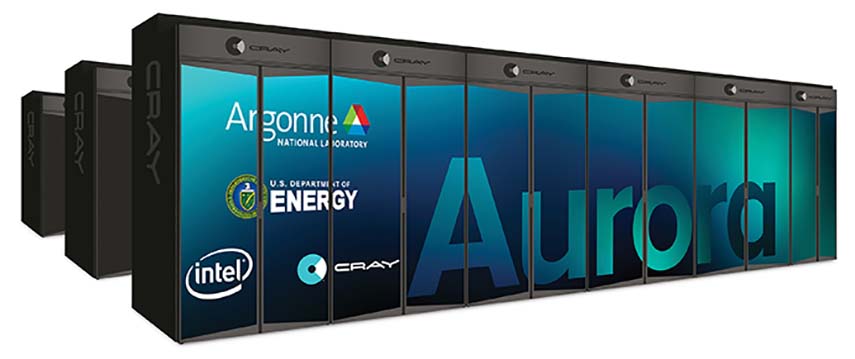Intel and the US Department of Energy (DOE) will deliver the first supercomputer with a performance of one exaFLOP in the US. The contract is valued at more than $500-million and will be delivered to Argonne National Laboratory by Intel and sub-contractor Cray in 2021.
The system being developed at DOE’s Argonne National Laboratory in Chicago, named “Aurora,” will be used to dramatically advance scientific research and discovery.
The Aurora system’s exaFLOP of performance – equal to a “quintillion” floating point computations per second – combined with an ability to handle both traditional high-performance computing (HPC) and artificial intelligence (AI) will give researchers an unprecedented set of tools to address scientific problems at exascale.
These breakthrough research projects range from developing extreme-scale cosmological simulations, discovering new approaches for drug response prediction and discovering materials for the creation of more efficient organic solar cells.
“Achieving exascale is imperative, not only to better the scientific community, but also to better the lives of everyday Americans,” says US secretary of energy Rick Perry. “Aurora and the next generation of exascale supercomputers will apply HPC and AI technologies to areas such as cancer research, climate modeling and veterans’ health treatments. The innovative advancements that will be made with exascale will have an incredibly significant impact on our society.”
“Today is an important day not only for the team of technologists and scientists who have come together to build our first exascale computer – but also for all of us who are committed to American innovation and manufacturing,” says Bob Swan, Intel CEO. “The convergence of AI and high-performance computing is an enormous opportunity to address some of the world’s biggest challenges and an important catalyst for economic opportunity.”
“There is tremendous scientific benefit to our nation that comes from collaborations like this one with the Department of Energy, Argonne National Laboratory, and industry partners Intel and Cray,” says Argonne National Laboratory director Paul Kearns. “Argonne’s Aurora system is built for next-generation artificial intelligence and will accelerate scientific discovery by combining high-performance computing and artificial intelligence to address real world problems, such as improving extreme weather forecasting, accelerating medical treatments, mapping the human brain, developing new materials and further understanding the universe – and that is just the beginning.”
The foundation of the Aurora supercomputer will be new Intel technologies designed specifically for the convergence of artificial intelligence and high-performance computing at extreme computing scale. These include a future generation of the Intel® Xeon® Scalable processor, Intel’s Xe compute architecture, a future generation of Intel Optane DC Persistent Memory, and Intel’s One API software. Aurora will use Cray’s next-generation supercomputer system, code-named “Shasta,” which will comprise more than 200 cabinets and include Cray’s Slingshot high-performance scalable interconnect and the Shasta software stack optimised for Intel architecture.
“Cray is proud to be partnering with Intel and Argonne to accelerate the pace of discovery and innovation across a broad range of disciplines,” says Peter Ungaro, president and CEO of Cray. “We are excited that Shasta will be the foundation for the upcoming exascale-era characterized by extreme performance capability, new data-centric workloads and heterogeneous computing.”
What is exascale computing?
 Extract from a blog by Rajeeb Hazra, responsible for leading Intel’s Enterprise IT and Technical Computing solutions into the data center for enterprise and government customer segments
Extract from a blog by Rajeeb Hazra, responsible for leading Intel’s Enterprise IT and Technical Computing solutions into the data center for enterprise and government customer segments
Today is an exciting day for the future of science and the tech industry. Our announcement today that Intel will deliver the U.S.’ first exascale supercomputer for the Department of Energy is a key moment in the evolution of the industry and a testament of our commitment to deliver leading-edge technologies in partnership with government and industry.
For several decades, Intel has been a proud partner of the U.S. national laboratories, helping accelerate U.S. science and innovation via deep engagements across a range of technologies, particularly in high performance computing.
But today is unique in the scale, capability and impact of the supercomputer we’re announcing for delivery in 2021. Intel, with the close collaboration of our partners Argonne National Labs and Cray, will deliver the “Aurora” supercomputer which will have a performance of one exaFLOP – a quintillion floating point operations per second. In addition, this system is designed to enable the convergence of traditional HPC, data analytics, and artificial intelligence – at exascale.
So, what makes this engagement significant and exciting?
First, achieving exascale is a national priority to harness a level of computing performance the world has not yet seen, with potential benefits across all of society – such as health care, transportation, agriculture, and national security.
The exascale computing capability will accelerate the United States’ technology leadership and enable continued competitiveness across economic, scientific, and national priorities in the 21st century. These technology innovations will drive benefits beyond high-end supercomputers as they are adopted across the broader ecosystem.
Second, deepening this critical public-private collaboration will help proliferate the sharing of research and development advances across government, industrial, and academic sectors. Third, the convergence of high performance computing and AI is enabling researchers to harness data in completely new and exciting ways.
Aurora will enable next-generation innovation across a spectrum of scientific fields and economic opportunities. Some specific examples I’m most excited by are deep learning for cellular or genetic personalized medicine, real-time global public heath mapping, and the discovery of transformative materials for next-generation clean energy.
Main picture: Intel will deliver the Aurora supercomputer, the United States’ first exascale system, to Argonne National Laboratory in 2021. Aurora will incorporate a future Intel Xeon Scalable processor, Intel Optane DC Persistent memory, Intel’s Xe compute architecture and Intel OneAPI programming framework — all anchored to Intel’s six key pillars of innovation. (Credit: Argonne National Laboratory)

